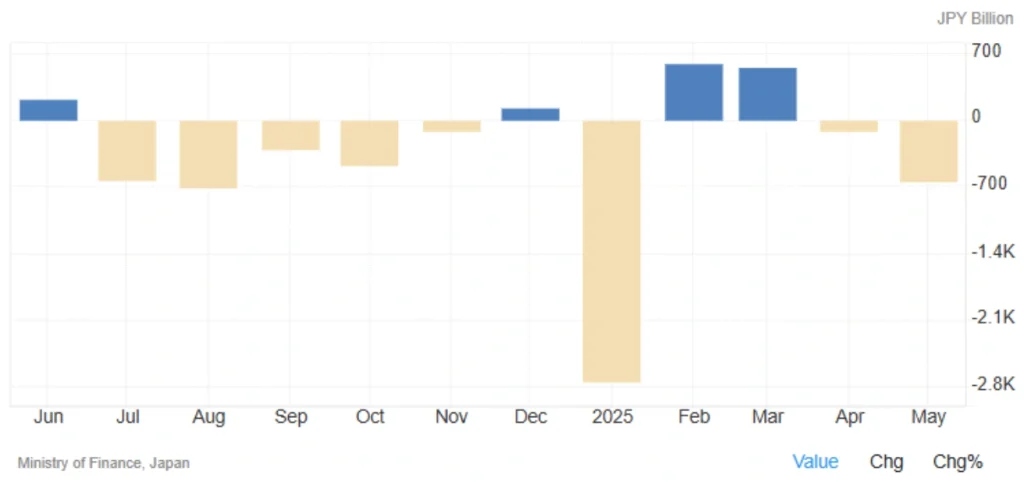
Japan’s Trade Deficit Narrows in May 2025: Imports Plunge Sharply
Japan’s trade deficit in May 2025 dropped to ¥637.6 billion, a significant improvement from ¥1,225.2 billion recorded in the same month last year. This figure also beat market expectations of a ¥893 billion shortfall.
However, the improvement did not come from stronger exports. Instead, it was mainly due to a steep decline in imports, which reflects weak domestic demand and continued pressure from U.S. tariffs.
Key Trade Figures – May 2025
| Indicator | Value | Change | Market Forecast |
|---|---|---|---|
| Trade Deficit | ¥637.6B | Sharp Decrease | ¥893B Deficit Expected |
| Exports | ¥8.13T | -1.7% YoY | Down after April’s 2.0% growth |
| Imports | ¥8.77T | -7.7% YoY | Bigger drop than expected (-6.7%) |
Educational Insight: What Is the Trade Balance?
The Trade Balance (BoT) is the difference between a country’s exports and imports during a specific period.
- Trade Surplus = Exports > Imports
- Trade Deficit = Imports > Exports
It is calculated using customs data and is a key macroeconomic indicator that reflects a country’s economic health and global competitiveness.
A persistent deficit can weaken the local currency and indicate structural economic issues, such as low domestic demand or inefficient production systems.

Market Impact Analysis
💱 Forex & Currency Markets
- Lower imports = reduced demand for foreign currencies.
- This could strengthen the Japanese yen (¥), especially if the Bank of Japan (BoJ) maintains a cautious stance.
- However, falling exports due to U.S. tariffs may limit the yen’s gains.
📉 Japanese Stock Market
- Export-heavy sectors (like automobiles and electronics) may face profit pressures.
- On the flip side, domestic-focused companies that rely less on imported materials may benefit.
Read More: Japan’s Economy Contracts in Q1 2025
🛢 Commodities Market
- Falling imports, especially in energy, may signal slowing industrial activity.
- This can be a negative indicator for global oil demand.
Cryptocurrency Market
- In times of economic slowdown and weak trade, interest in alternative assets like crypto may rise in Japan—especially if loose monetary policies continue.
🏦 Bank of Japan Policy Outlook
- The sharp drop in imports might push the BoJ to delay tightening policies.
- Supporting domestic demand could become a higher priority.
Conclusion: Risks, Opportunities & What Lies Ahead
Japan’s narrowing trade deficit may seem positive on the surface—but it’s not driven by strength. It reflects a weakened domestic economy and reduced consumption, not growth in exports.
📌 Key Takeaways:
- 🔹 Short-Term: Yen may gain slightly, but continued export decline would pressure the currency.
- 🔹 Mid-Term: Watch for BoJ’s stimulus plans and U.S.–Japan trade talks.
- 🔹 Investor Tip: Consider focusing on domestically oriented sectors over export-reliant ones.
Share
Hot topics

What Is Forex Fundamental Analysis?
Forex trading can seem confusing from the outside. Charts move quickly, prices change every second, and traders talk about pips (the smallest unit of price movement), spreads (the difference between...
Read more




Submit comment
Your email address will not be published. Required fields are marked *